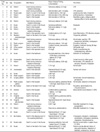Abstract
Propofol is a widely used anesthetic in anesthesia and sedation. Recent cases of propofol-induced death have been associated with adverse effects, abuse, or intoxication. However, there are few forensic reports of propofol-associated death. We reviewed and analyzed 36 cases of death related to propofol administration recorded by the National Forensic Service in 2000-2011. The number of women was 28 (77.8%). Subjects in their 20s and 30s accounted for 61.1% of cases. Cause included medical accidents, 16 (44.4%); suicides, 2 (5.6%); and undetermined, 18 (50%; suicide/accident). Of the 16 medical accidents, 8 were internal medicine cases (conscious sedation endoscopy), 3 surgical cases, 3 plastic surgery cases, 1 urology case, and 1 obstetrics and gynecology case. In 20 cases of suicide or undetermined (suicide/accident), the victims were nurses (9 cases), doctors (4 cases), hospital administrators (2 cases), homemakers (2 cases), bar hostesses (2 cases) and an office worker (1 case). The doctor included 2 plastic surgeons, an internist, and a resident anesthesiologist. The autopsy findings were nonspecific; congested parenchymal organs (34 cases), pulmonary edema (8 cases), cerebral edema (2 cases), pulmonary and cerebral edema (2 cases), putrefaction (2 cases), mucosal petechiae in the interior of the larynx (1 case), and cerebral ischemic necrosis and pneumonia (1 case). The blood propofol concentrations ranged between 0.007 mg/L (cardiopulmonary resuscitation) or 0.23 mg/L (no cardiopulmonary resuscitation) and 4.38 mg/L in medical accident cases, and from 0.12 mg/L to 108.3 mg/L in suicide or undetermined (suicide/accident) cases. Other drugs were detected in 17 cases and alcohol was detected in only 2 cases. Blood concentrations in cases of medical accident were lower than in cases of undetermined cause.
References
1. Lee JW, Lee KY. Safe sedation in a private clinic. J Korean Med Assoc. 2011. 54:1179–1188.
2. Lee SA, Lee MS, Kim YA, Ahn WS, Lee HC. Propofol Abuse of the Medical Personnel in Operation Room in Korea. Korean J Leg Med. 2010. 34:101–107.
3. Eger EI 2nd. Characteristics of anesthetic agents used for induction and maintenance of general anesthesia. Am J Health Syst Pharm. 2004. 61:S3–S10.
4. Kirby RR, Colaw JM, Douglas MM. Death from Propofol: Accident, Suicide, or Murder? Anesth Analg. 2009. 108:1182–1184.
5. Kranioti EF, Mavroforou A, Mylonakis P, Michalodimitrakis M. Lethal self administration of propofol (Diprivan) A case report and review of the literature. Forensic Sci Int. 2007. 167:56–58.
6. Fulton B, Sorkin EM. Propofol. An overview of its pharmacology and a review of its clinical efficacy in intensive care sedation. Drugs. 1995. 50:636–657.
7. Marik PE. Propofol: therapeutic indications and side-effects. Curr Pharm Des. 2004. 10:3639–3649.
8. Klausz G, Rona K, Kristof I, Toro K. Evaluation of a fatal propofol intoxication due to self administration. Journal of Forensic and Legal Medicine. 2009. 16:287–289.
9. Cho H, Kim YM, Oh JH, et al. The effect of propofol for conscious sedation during colonoscopy - A Prosprective, Randomized study. Korean J Med. 2005. 69:30–38.
10. Langley MS, Heel RC. Profofol. A review of its pharmacodynamic and pharmacokinetic properties and use as intravenous anaesthetic. Drugs. 1988. 35:334–372.
11. Baset RC, Cravey RH. Disposition of Toxic Drugs and Chemicals in Man. 1994. 4th ed. Chemical Toxicology Inst;1325–1327.
12. Schneider U, Rada D, Rollnik JD, Passie T, Emrich HM. Propofol dependency after treatment of tension headache. Addict Biol. 2001. 6:263–265.
13. Follette JW, Farley WJ. Anesthesiologist Addicted to Propofol. Anesthesiology. 1992. 77:817–818.
14. Soyka M, Schutze CG. Propofol dependency (letter). Addiction. 1997. 92:1369–1370.
15. Roussin A, Nontastruc J-L, Lapeyre-Mestre M. Pharmacological and clinical evidences on the potential for abuse and dependence of propofol: a review of literature. Fundam Clin Pharmacol. 2007. 21:459–465.
16. Chao TC, Koh TH. The first fatal 2,6-diisopropylphenol (propofol) poisoning in Singapore: a case report. Forensic Sci Int. 1994. 66:1–7.
17. Drummer OH. A Fatality Due to Propofol Poisoning. J Forensic Sci. 1992. 37:1186–1189.
18. Iwersen-Bergmann S, Rosner P, Kuhnau HC, Junge M, Schmoldt A. Death after excessive propofol abuse. Int J Legal Med. 2001. 114:248–251.
19. Lee MS, Ahn WS. Designation of a new drug as a controlled substance. J Korean Med Assoc. 2011. 54:189–196.
20. Ward CF, Ward GC, Saidman LJ. Drug abuse in anesthesia training programs. A survey: 1970 through 1980. JAMA. 1983. 250:922–925.
21. Booth JV, Grossman D, Moore J, et al. Substance abuse among physicians: a survey of academic anesthesiology programs. Anesth Analg. 2002. 95:1024–1030.




 PDF
PDF ePub
ePub Citation
Citation Print
Print



 XML Download
XML Download